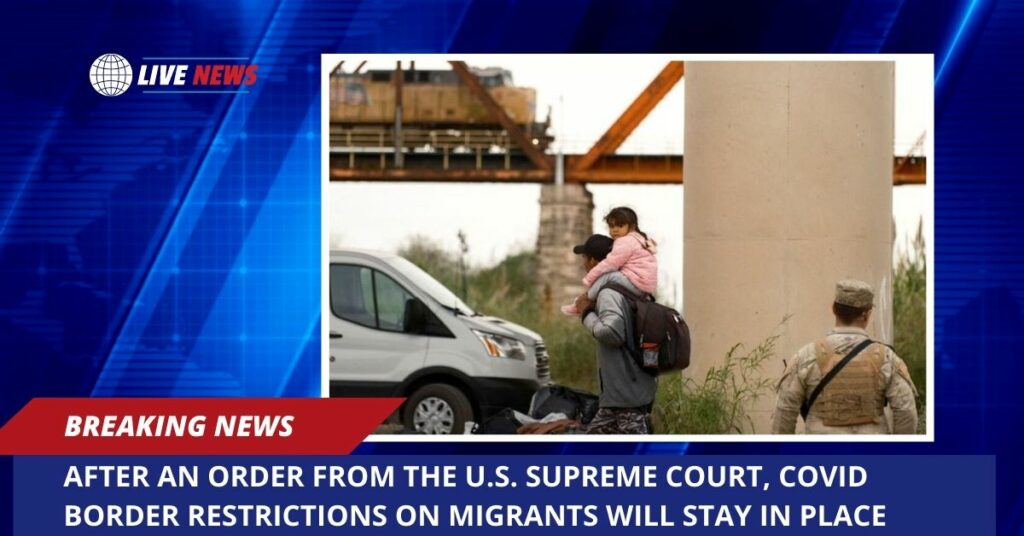Monday, the U.S. Supreme Court sided with Republicans who brought a legal challenge against COVID-era restrictions at the U.S.-Mexico border that have stopped hundreds of thousands of migrants from seeking asylum.
The restrictions, called Title 42, were implemented by former Republican President Donald Trump in March 2020, at the start of the COVID-19 pandemic. They allowed border agents to quickly send migrants back to Mexico without giving them a chance to ask for asylum in the U.S.
Before he became president in 2021, Democrat Joe Biden ran on a platform of overturning Trump’s strict immigration policies. However, Title 42 stayed in place for more than a year after he took office. The U.S. Centers for Disease Control and Prevention (CDC) said this year that Title 42 was no longer needed for public health reasons, and the Biden administration has said it wants it to end but will follow any court rulings.
In response to a lawsuit brought by migrants seeking asylum who the American Civil Liberties Union represented, a federal judge ruled last month that Title 42 was illegal. The judge said that the restrictions would be lifted on December 21. But 19 states with Republican attorneys general tried to change that decision by getting involved in the case. On Monday, they took their request to the Supreme Court, which leans conservative.
After a few hours, Chief Justice John Roberts put a short order that put Title 42 on hold until the court said otherwise. The court noted that the people involved in the legal dispute have until Tuesday at 5 p.m. ET (2200 GMT) to respond.
After what Robert did, the U.S. Department of Homeland Security (DHS) said, “Title 42 will remain in effect at this time, and people who try to enter the U.S. illegally will still be sent back to Mexico.” The Biden administration was getting ready for Title 42 to end on Wednesday. On Monday, White House press secretary Karine Jean-Pierre said that the White House was asking Congress for more than $3 billion to pay for more people, technology, places to hold migrants, and transportation at the U.S.-Mexico border.
According to Reuters and other news sources, U.S. officials were preparing for the possibility that 9,000 to 14,000 people per day would try to cross into the country if Title 42 was lifted. This is about double the current rate.
The Biden administration has been thinking about how to prepare for the end of Title 42. Government officials have been talking privately about Trump-style plans to stop people from crossing the border, such as making it illegal for single adults to ask for asylum at the U.S.-Mexico border.
Last week, DHS changed a six-pillar plan that calls for more people to be deported quickly if Title 42 is taken away. The revised DHS plan also says there could be more legal ways for migrants to come to the U.S. from abroad, like the program that started in October for Venezuelans.
BORDER CITIES OVERWHELMED
Since Biden took office in January 2021, about half of the record 4 million migrants who crossed the U.S.-Mexico border were sent back under Title 42, while the other half were allowed into the U.S. to work on their immigration cases. Only a few nationalities can return to Mexico, like some Central Americans and, more recently, Venezuelans.
El Paso, Texas, has been getting a lot of asylum-seeking migrants for a long time, including many Nicaraguans who can’t be sent back to Mexico. On Saturday, when the temperature dropped below freezing, the city’s mayor declared a state of emergency to get migrants off the streets. Democrat Henry Cuellar, whose district in South Texas borders Mexico, said that U.S. border officials told him that about 50,000 people are waiting in Mexico to cross.
“If Title 42 stays in place, we’ll have to keep waiting,” said Lina Jaouhari, a Venezuelan migrant who said she tried to enter the United States from Ciudad Juarez on December 1 but was sent back to Mexico because of Title 42. “It won’t help to cross again if we know they’ll send us back.”
In El Paso, shelters have had a hard time taking care of migrants, even though many of them are going to visit family in other parts of the U.S. Rescue Mission of El Paso, a shelter near the border, took in 280 people last week, way more than its 190-person limit. The shelter’s marketing director told Reuters that people slept on cots and air mattresses in the chapel, library, and conference rooms. “We have to tell some people, ‘We don’t have room,'” she said. “They beg to sit on the ground.”
Don’t be shy about sharing your ideas in the comments if you enjoyed this article. As always, check back here, Journalistpr.com. for updates.

